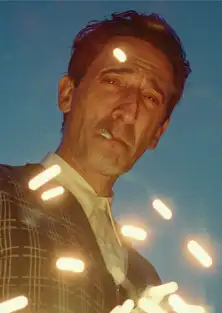Quick take: The Brutalist is a testimony to the sufferings immigrants go through. Adrien Brody gives another award-worthy performance.
Critic’s rating 4.5/5
What do we, as Indians, know of the immigrant experience? My own family migrated from Rawalpindi, now in Pakistan, in 1947. My grandfather and father saw the kind of horrors unfold during that journey which can’t be described. Those scars never quite went away. They often spoke of being treated as outsiders in their own country. Refugee became a derogatory word. It took a lot of time for them to set up roots again and accept their new reality, move on. So many connections got lost during the transition…
The Brutalist tells the fictional story of a Hungarian-Jewish architect, László Tóth (Adrien Brody), a concentration camp survivor, who gets a chance to emigrate to America in 1947. His wife Erzsébet (Felicity Jones) and orphaned niece Zsófia (Raffey Cassidy) are still stuck in Europe. He pines for them and even takes to heroin abuse to assuage his pain. He’s shown writing long letters to them, penning down his pain with brutal honesty. The letters become a diary of sorts of his seclusion. Later, we discover that due to their suffering in wartime, Erzsébet is confined to a wheelchair from osteoporosis caused by famine, and Zsófia is unable to speak. At first he stays with his cousin Attila (Alessandro Nivola), a furniture showroom owner and Attila’s Catholic wife, Audrey (Emma Laird) but later he’s asked to go away. He can’t find white collar jobs and is forced to work as an odd jobs man. His only friend is Gordon (Isaach De Bankolé), a Black American who has been cast solely to show how the Jewish community found solidarity with the Black community in America. He longs for a second chance and finds it in the person of Harrison Van Buren (Guy Pearce), a self-obsessed millionaire who wants to create a landmark building, comprising a library, theater, gymnasium, and a chapel. It’s to be dedicated to the memory of his late mother and be a public place open to the people of Pennsylvania.
Van Buren is a collector and perhaps a Holocaust survivor is his latest acquisition. He’s both repulsed and fascinated by Tóth, aware of his genius but also wary of his alienness. In one particular scene, he compares the architect to a shoeshine boy, throwing a coin at him and then demanding back that coin, showcasing America’s contradictory attitudes towards the immigrants. Van Buren’s entitled son, Harry Lee Van Buren (Joe Alwyn), tells Tóth that while they tolerate him, they can never be his friends. The truth hits home during the climax, when the relationship between Van Buren and Tóth goes totally downhill. The scene is a brutal reminder of how the capitalist society can literally screw the immigrants whenever they feel like as they know there won’t be any repercussions. Ironically, it’s something actually going on in America right now. Another real-life political event which the film hints at is the formation of the state of Israel. Tóth’s niece and her fiance feel it’s the duty of every jew to go to the new nation and be part of its building process, a theory which he doesn’t hold true to. There have always been hardliners when it comes to Israel and those differences have remained till now.
Disclaimer: There was no Hungarian-Jewish architect, called László Tóth in reality. Though Adrien Brody’s life-like performance may convince you otherwise. He has played a Holocaust survivor before in The Pianist (2002), which indeed was based on the life of Polish-Jewish pianist, composer and Holocaust survivor Wladyslaw Szpilman. Brody has perhaps unconsciously drawn upon his earlier role to achieve the nuances required. He won an Oscar for it and looks like a strong contender this year as well. That said, it’s very much true that thousands of Hungarian Jews were persecuted during World War II by Nazi forces. Some indeed migrated to America and slowly built a home for themselves there. Brutalism is a form of architecture. Brutalism insists that buildings should serve a clear purpose for the humans who use them. At the end, we learn that Tóth’s inspiration for the Van Buren institute were his and his wife’s barracks from their concentration camp. It was his way of giving an epitaph to the Nazi horrors. Kudos to production designer Judy Becker, whose colossal architectural pieces make the film and the central character feel real. The film was shot using the VistaVision process and cameras that involves shooting horizontally on 35mm film stock. Seeing the finished product on an IMAX screen makes for a haunting experience indeed. Cinematographer Lol Crawley has produced a visual masterpiece that can be savoured for its photography alone.
If we can find a complaint about The Brutalist, it is that it focuses solely on László Tóth’s character without going in depth about the experiences his wife and niece went through. Surely the female perspective too needed to be brought out. Erzsébet is an Oxford educated journalist but we only see her as a frustrated wife of a troubled genius, which in itself is a much abused trope. Felicity Jones, despite the restrictions, is in fine form here as Erzsébet and knocks your socks off in the climax scene through her performance. Guy Pearce has given a career defining role as Harrison Van Buren. You’ll love to hate him for what he does to Tóth. What can we say about Adrien Brody? He has given us another moving homage to the human condition. His László Tóth never loses grace or dignity even as he struggles with despair and loss. His ambition to craft something new and make his mark upon a foreign land is clear even on the darkest of days.
The film is 3 hours and 34 minutes long and has an inbuilt, timed interval of 15 minutes. However, it’s unlikely you’ll get bored, despite the long run time. Watch The Brutalist for the performances and for its political commentary. It’s trying to say a great many things and will require a rewatch and discussions to assimilate them all.
News Credit : filmfare.com










